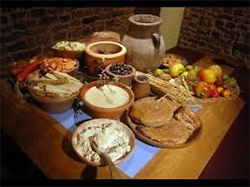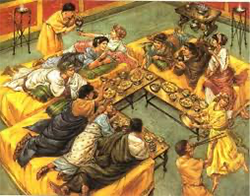Roman people ate a variety of food, depending on where they lived and what they could afford. As the civilization progressed, so did the number and variety of foods available.

In general, Roman people ate three meals a day. Some people skipped a morning meal, either because they couldn't afford it or because it wasn't practicable.
Breakfast was ientaculum. Typical breakfast foods included these:
- a wheat pancake
- dates
- honey
Lunch, generally eaten at midday, was prandium (or sometimes cibus meridianus). Typical lunch foods included these:
- fish
- cold meat
- vegetables
- bread
- cheese
- leftovers from the previous night's meal
Dinner, the evening meal, was cena. Typical dinner foods included these:
- puls, a porridge (made from emmer wheat, water, salt, and fat)
- vegetables
- (if they could afford it) eggs, cheese, fish, and meat such as pork, venison, lamb, chicken, pheasant. More expensive meats included board, hare, ostrich and peacock.
In earlier times, Romans would eat their main meal, cena, at midday and then have a lighter meal, vesperna at night. As trade with other peoples grew, the Romans switched to having their cena in the evening.
As Roman society progressed, its people included dessert as part of their evening meal. By the time of the Empire, it was not uncommon for people who afford it to partake in a cena that had three courses: gustatio (appetizer), primae mensae (main course), and secundae mensae (second course, or dessert). The Latin expression for a full-course cena was ab ovo usque male ("from the egg to the apples.")

The Roman people ate generally with their fingers. They had spoons, with which they ate soup. Most of their food, though, was able to be picked up and so was in bite-size pieces or could at least fit in one hand. The Romans would use a knife to cut up their food.
Roman adults did not sit in chairs to eat if they could afford it. Rather, they lay, generally on one side, on a couch that was arranged around a table. Children could sit while eating; the same was true of slaves. Those who couldn't afford a couch sat in chairs to eat or stood.
People would sit or recline around three sides of a square or rectangular table (the triclinium). The fourth side was left open for servants or others to serve and remove the food.
To drink, Romans generally had wine or something other than water, since the water wasn't always clean. Sometimes, they would mix honey with wine to create a drink called mulsum or mix in raisins to make passum. A popular drink among those who couldn't afford much was posca, a watered-down wine to which were added spices to improve the taste. Posca was also popular with the legions on campaign or patrol.
Bread was far and away the most popular food the Romans ate. They would have it with most meals and would often pair it with eggs, cheese, honey, olives, and grapes. Sweeter bread-like foods included wine cakes and fruit tarts. The Romans used refined wheat, which was more expensive, to make white bread. Those who had less money would eat darker colored bread. Some bread was made with corn or spelt.
Fruits that Romans typically ate included apples, apricots, blackberries, cherries, currants, figs, grapes, melons, peaches, pears, plums, and quinces.
The variety of vegetables was extensive (and depended on what people could afford): asparagus, beets, broccoli, cabbage, carrots, celery, chard, cucumber, eggplant, kale, leeks, lettuce, mushrooms, radishes, spinach, tomatoes, turnips, and zucchini.
The Romans also ate legumes, such as beans and lentils and peas. These were often mixed into bread.
Something often added to foods was carob, which had a chocolate-like flavor. The Romans used this to make foods taste better. Another common additive to foods was garum, a fish sauce.
Wealthy Romans threw dinner parties (convivia). They would eat and drink in small doses for many hours. Hosts of dinner parties often sent visitors home with food left over once the dinner party had ended. Regular guests would bring their own ancient equivalent of a "doggy bag," and to do so was considered a compliment to the host about how good the food, drink, and company were.
Not all houses had a kitchen. Romans who wanted food dishes that were already prepared often went to the equivalent of a fast food restaurant called a thermopolia.